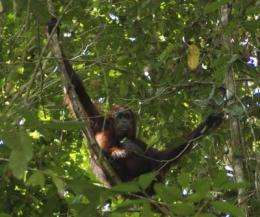Wild orangutans stressed by eco-tourists, but not for long, study out of Borneo finds

Wild orangutans that have come into contact with eco-tourists over a period of years show an immediate stress response but no signs of chronic stress, unlike other species in which permanent alterations in stress responses have been documented, new research from an Indiana University anthropologist has found.
IU anthropologist Michael P. Muehlenbein can't say yet what makes the wild orangutans of Borneo deal with stress differently than other species in other locations, but an analysis of orangutan stress hormone levels recorded before, during and after the apes interacted in the wild with eco-tourists found evidence of acute elevation of the stress hormone cortisol the day of an interaction, with levels then returning to baseline afterward.
By analyzing fecal glucocorticoid metabolite (fGM) levels of orangutans in the Lower Kinabatangan Wildlife Sanctuary in Sabah, Malaysia, the team led by Muehlenbein was looking to, among other things, gather evidence about levels of disturbance on wildlife exposed to eco-tourism, a multi-billion-dollar-a-year industry that is growing annually. Red Ape Encounters, a community-owned and -operated eco-tourism program in Sabah that assisted with the research, facilitates the only trekking program for wild orangutans in the world.
"Revenue can enhance economic opportunities for the locales involved, and it can support environmental education, protect natural and cultural heritage, and be used to conserve biodiversity," Muehlenbein said. "But rapid, unmonitored development of nature-based tourism can also lead to habitat degradation and negative impacts on the very species we wish to protect. Given the increasing demand of tourists to encounter wild orangutans, it is critical to evaluate any potential physiological effects this and future programs may have on this charismatic and endangered species."
Bornean orangutans (Pongo pygmaeus morio) are considered an endangered species by the International Union for Conservation of Nature, which produces the Red List of Threatened Species.
Eco-tourism guidelines used by Red Ape Encounters include limiting visitation groups to seven people for no more than one hour; excluding sick tourists; maintaining a 10-meter minimum distance; and requiring appropriate behavior. The company hosts about 250 tourists per year, with most of the visitor activity centered on the two wild habituated orangutans used in the study: Jenny, an adult approximately 32 years old, and her 11-year-old son Etin.
To produce the results, researchers collected fecal samples from Jenny and Etin in association with 25 unique tourism visits, along with fecal samples collected from several previously unidentified wild unhabituated orangutans. After developing standardized hormone degradation rates through earlier comparative studies of samples from captive orangutans at Cleveland Metroparks Zoo and those from two other wild orangutans in Borneo, the team was able to collect samples within an optimum time after defecation in order to limit the effects of time-based physiological processes that degrade samples.
"When we compared samples from Jenny and Etin obtained the day before, the day of and the day after tourist visitation, we found that stress hormone levels were significantly elevated in samples collected the day after tourist visitation, which is indicative of elevated cortisol production on the previous day," Muehlenbein said. "As for the unknown wild orangutans that we were also able to gather samples from, we found numerically, but not statistically, higher stress hormone levels in these animals following contact with researchers than in the habituated animals."
Different species and populations of animals likely react differently to human exposure, and those differences may be due to variation in tourism intensity (including distance between animals and visitors), the animal's stage of habituation, animal temperament, and even the presence of adequate coping or escape mechanisms, he believes.
"Transiently elevated stress hormone levels must be interpreted conservatively, as these may simply reflect normal responses to stimuli," Muehlenbein said. "But nature-based tourism programs that result in permanent alterations of stress physiology in their animals cannot be viewed as sustainable. However, low levels of predictable disturbance likely result in low physiological impact on these orangutans."
On a wider scale, he pointed out, animal usage should be kept minimal -- at least for pregnant females and ill animals and during times of resource restriction -- and the habituation processes gradual for all animals involved in eco-tourism.
More information: "Ape conservation physiology: Fecal glucocorticoid responses in wild Pongo pygmaeus morio following human visitation," published March 15, 2012, in PLoS ONE, by Michael P. Muehlenbein, Marc Ancrenaz, Rosman Sakong, Laurentius Ambu, Sean Prall, Grace Fuller and Mary Ann Raghanti.
Journal information: PLoS ONE
Provided by Indiana University



















